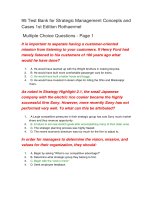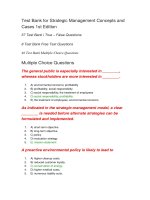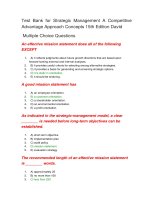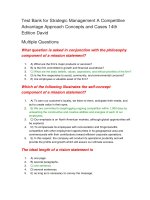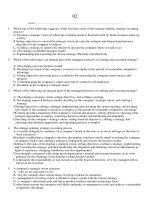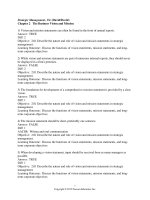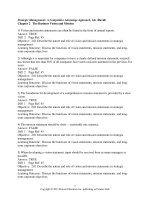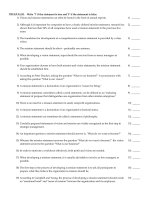Strategic Management: A Competitive Advantage Approach, Concepts and Cases, Global Edition, 17th edition
Bạn đang xem bản rút gọn của tài liệu. Xem và tải ngay bản đầy đủ của tài liệu tại đây (8.12 MB, 681 trang )
GLOBAL
EDITION
STRATEGIC
MANAGEMENT
A Competitive Advantage Approach
Concepts and Cases
17th
Edition
Fred R. David, Forest R. David,
and Meredith E. David
STRATEGIC
MANAGEMENT
Concepts and Cases
A COMPETITIVE ADVANTAGE APPROACH
1
This page is intentionally left blank
STRATEGIC
MANAGEMENT
SEVENTEENTH
EDITION
GLOBAL
EDITION
Concepts and Cases
A COMPETITIVE ADVANTAGE APPROACH
Fred R. David
Francis Marion University
Florence, South Carolina
Forest R. David
Strategic Planning Consultant
Ocean Isle Beach, North Carolina
Meredith E. David
Baylor University
Waco, Texas
Please contact with any queries on this content.
Cover Image: artacet/Shutterstock
Acknowledgments of third-party content appear on the appropriate page within the text.
Pearson Education Limited
KAO Two
KAO Park
Hockham Way
Harlow
Essex
CM17 9SR
United Kingdom
and Associated Companies throughout the world
Visit us on the World Wide Web at: www.pearsonglobaleditions.com
© Pearson Education Limited 2023. All Rights Reserved.
The rights of Fred R. David, Forest R. David, and Meredith E. David to be identified as the authors of this work have been
asserted by them in accordance with the Copyright, Designs and Patents Act 1988.
Authorized adaptation from the United States edition, entitled Strategic Management: Concepts and Cases, 17th Edition, ISBN
978-0-135-17394-7 by Fred R. David, Forest R. David, and Meredith E. David, published by Pearson Education © 2020.
All rights reserved. No part of this publication may be reproduced, stored in a retrieval system, or transmitted in any form or
by any means, electronic, mechanical, photocopying, recording or otherwise, without either the prior written permission of the
publisher or a license permitting restricted copying in the United Kingdom issued by the Copyright Licensing Agency Ltd,
Saffron House, 6–10 Kirby Street, London EC1N 8TS. For information regarding permissions, request forms, and the
appropriate contacts within the Pearson Education Global Rights and Permissions department, please visit
www.pearsoned.com/permissions/.
All trademarks used herein are the property of their respective owners. The use of any trademark in this text does not vest in
the author or publisher any trademark ownership rights in such trademarks, nor does the use of such trademarks imply any
affiliation with or endorsement of this book by such owners.
This eBook is a standalone product and may or may not include all assets that were part of the print version. It also does not
provide access to other Pearson digital products like Revel. The publisher reserves the right to remove any material in this
eBook at any time.
British Library Cataloguing-in-Publication Data
A catalogue record for this book is available from the British Library
ISBN 10: 1292441402
ISBN 13: 9781292441405
eBook ISBN 13: 9781292441351
Typeset in by B2R Technologies Pvt. Ltd.
Brief Contents
Preface
15
Acknowledgments
25
About the Authors
27
PART 1
Overview of Strategic Management
Chapter 1
30
The Nature of Strategic Management
31
THE COHESION CASE: COCA-COLA COMPANY, 2018
PART 2
Strategy Formulation
Chapter 2
Chapter 3
Chapter 4
Chapter 5
Chapter 6
PART 3
PART 4
228
Implementing Strategies: Management and Marketing Issues 229
Implementing Strategies: Finance and Accounting Issues 269
Strategy Evaluation and Governance
Key Strategic-Management Topics
Chapter 10
Chapter 11
PART 6
Business Vision and Mission 71
The External Assessment 93
The Internal Assessment 123
Strategies in Action 155
Strategy Analysis and Choice 191
Strategy Evaluation and Governance
Chapter 9
PART 5
70
Strategy Implementation
Chapter 7
Chapter 8
56
298
299
326
Business Ethics, Environmental Sustainability, and Corporate Social Responsibility
Global and International Issues 351
Strategic-Management Case Analysis
376
How to Prepare and Present a Case Analysis
Glossary
327
377
659
Name Index
Subject Index
667
673
5
This page is intentionally left blank
Contents
Preface
15
Acknowledgments
25
About the Authors
27
Exercise 1B: Enter Coca-Cola Vitals into the Strategic Planning
Template 66
Set 2: Strategic Planning for My University 66
Exercise 1C: Perform SWOT Analysis for My University 66
Set 3: Strategic Planning to Enhance My Employability 67
Exercise 1D: Perform SWOT Analysis on Myself 67
Set 4: Individual versus Group Strategic Planning 67
Exercise 1E: How Detrimental Are Various Pitfalls in Strategic
Planning? 67
PART 1 Overview of Strategic
Management 30
Chapter 1 The Nature of Strategic
Management 31
What Is Strategic Management?
PART 2 Strategy Formulation
32
Chapter 2 Business Vision and Mission
EXEMPLARY STRATEGIST SHOWCASED: COACH VINCE
LOMBARDI 32
Strategic Planning
33 • The Strategic-Management Model
34
Stages of Strategic Management 35
Integrating Analysis and Intuition 36
GLOBAL CAPSULE 1: MOBIKE: GLOBAL BIKE RENTING TAKES
OFF LIKE A JET PLANE 38
38
Competitive Advantage 38 • Strategists 38
• Vision and Mission Statements 39 • External
Opportunities and Threats 40 • Internal Strengths and
Weaknesses 40 • Long-Term Objectives 41
• Strategies 41 • SWOT Analysis 42 • Annual
Objectives 42 • Policies 44
•
Nonfinancial Benefits
The Process of Developing Vision and Mission Statements 81
45
Evaluating and Writing Mission Statements 81
IMPLICATIONS FOR STRATEGISTS 83
IMPLICATIONS FOR STUDENTS 84
Chapter Summary 84
Key Terms and Concepts 85
Issues for Review and Discussion
IMPLICATIONS FOR STRATEGISTS 49
IMPLICATIONS FOR STUDENTS 50
85
ASSURANCE-OF-LEARNING EXERCISES
52
MINI-CASE ON TESLA, INC. (TSLA): WHAT AMERICAN COMPANY
DOES THE BEST JOB OF STRATEGIC PLANNING, AND HOW IS IT
DONE? 53
Web Resources 54
Current Readings 54
Endnotes 55
THE COHESION CASE: COCA-COLA COMPANY, 2018
ASSURANCE-OF-LEARNING EXERCISES 65
75
The Importance (Benefits) of Vision and Mission
Statements 79
Why Some Firms Do No Strategic Planning 46
Pitfalls in Strategic Planning 46
Comparing Business and Military Strategies 46
Developing Employability Skills 48
Chapter Summary 51
Key Terms and Concepts 51
Issues for Review and Discussion
Vision Statement Analysis
Mission Statements: What Is Our Business? 75
Characteristics of a Mission Statement 76
Components of a Mission Statement 77
ETHICS CAPSULE 2: FACEBOOK: CHANGING OUR MISSION TO
ENHANCE OUR ETHICS AND INTEGRITY 79
Benefits of Engaging in Strategic Management 44
45
EXEMPLARY STRATEGIST SHOWCASED: FREDERICK W. SMITH,
FOUNDER AND CEO OF FEDEX CORPORATION 72
GLOBAL CAPSULE 2: LINKEDIN: CLEAR CORE VALUES, VISION,
AND MISSION LEAD TO GLOBAL PROMINENCE 73
Vision Statements: What Do We Want to Become? 73
Characteristics of a Vision Statement 74
Adapting to Change 37
Financial Benefits
71
Core Values Statements: What Is Our Foundation? 72
ETHICS CAPSULE 1: WHAT ETHICS VARIABLE IS MOST
IMPORTANT IN DOING BUSINESS? 35
Key Terms in Strategic Management
70
56
Set 1: Strategic Planning for Coca-Cola 65
Exercise 1A: Gather Strategy Information for Coca-Cola Company 65
86
Set 1: Strategic Planning for Coca-Cola 86
Exercise 2A: Develop an Improved Coca-Cola Vision Statement 86
Exercise 2B: Develop an Improved Coca-Cola Mission Statement 86
Exercise 2C: Compare Coca-Cola’s Mission Statement to a Rival
Firm’s 87
Set 2: Strategic Planning for My University 87
Exercise 2D: Compare Your University’s Vision and Mission Statements to
Those of a Rival Institution 87
Set 3: Strategic Planning for Myself 87
Exercise 2E: Develop a Vision and Mission Statement for
Yourself 87
Set 4: Individual versus Group Strategic Planning 88
Exercise 2F: What Is the Relative Importance of Each of the Nine
Components of a Mission Statement? 88
7
8
CONTENTS
MINI-CASE ON FORD MOTOR COMPANY (F): EVALUATE
FORD’S VISION FOR THE FUTURE AND MISSION FOR THE
PRESENT 89
Set 4: Individual versus Group Strategic Planning 118
Exercise 3H: What External Forces Are Most Important in Strategic
Planning? 118
Web Resources 90
Current Readings 90
Endnotes 91
MINI-CASE ON SAM’S CLUB: SAM’S CLUB IS BOOMING IN
CHINA 119
Chapter 3 The External Assessment
93
EXEMPLARY STRATEGIST SHOWCASED: BEN SILBERMANN,
CEO AND COFOUNDER OF PINTEREST 94
The External Assessment Phase of Strategy Formulation 95
Key External Forces 95 • The Actionable-QuantitativeComparative-Divisional (AQCD) Test 95
10 External Forces that Impact Organizations
96
Economic Forces 96 • Social, Cultural, Demographic, and
Environment (SCDE) Forces 97 • Political, Governmental, and
Legal Forces 97
ETHICS CAPSULE 3: PRESERVE ALASKA WILDLIFE OR BOOST
ALASKA ECONOMY? 98
Technological Forces
99
• Competitive Forces 100
GLOBAL CAPSULE 3: WHAT COMPANY IS GROWING FASTEST
GLOBALLY? 101
Porter’s Five-Forces Model
101
Rivalry among Competing Firms 102 • Potential Entry of New
Competitors 103 • Potential Development of Substitute
Products 103 • Bargaining Power of Suppliers 103 •
Bargaining Power of Consumers 104
Key Sources of Information for an External Audit
Forecasting and Making Assumptions 105
Making Assumptions
105
106
The External Factor Evaluation Matrix
107
Steps to Develop an EFE Matrix 107 • Step 1: Develop a Full and
Narrow List of Key External Factors 107 • Step 2: Assign Weights
to Key External Factors 108 • Step 3: Assign Ratings to Key
External Factors 108 • Step 4: Obtain Weighted Scores 108
• Step 5: Obtain Total Weighted Score 108 • An Example EFE
Matrix 109
The Competitive Profile Matrix
110
IMPLICATIONS FOR STRATEGISTS 112
IMPLICATIONS FOR STUDENTS 113
Chapter Summary 114
Key Terms and Concepts 114
Issues for Review and Discussion
Chapter 4 The Internal Assessment 123
The Internal Assessment Phase of Strategy Formulation
124
EXEMPLARY STRATEGIST SHOWCASED: ELON MUSK, CEO
AND COFOUNDER OF TESLA, INC. AND SPACE EXPLORATION
TECHNOLOGIES CORPORATION (SPACEX) 124
Resource-Based View 125 •
Key Internal Forces
125
ETHICS CAPSULE 4: THE SAGEBRUSH LIZARD VERSUS THE BIG
OIL MAN 126
Management
126
Planning 127 • Organizing 127 • Motivating 127
• Controlling 128 • Integrating Strategy and Culture 129
• Management Audit Checklist of Questions 130
Marketing
131
Marketing Research and Target Market Analysis 131 • Product
Planning 132 • Pricing 133 • Promotion 133
GLOBAL CAPSULE 4: BITCOIN: THE NEW GLOBAL
CURRENCY 134
Channels of Distribution 134 •
Checklist of Questions 135
Marketing Audit
Finance and Accounting 135
Finance and Accounting 135 • Financial Ratios
• Finance and Accounting Audit Checklist 138
136
Management Information Systems 140
Business Analytics
140
The Internal Factor Evaluation (IFE) Matrix 141
The Actionable-Quantitative-Comparative-Divisional (AQCD)
Test 141 • Steps in Developing an IFE Matrix 142 • Step 1:
Develop a Full and Narrow List of Key Internal Factors 142 • Step 2:
Assign Weights to Key Internal Factors 142 • Step 3: Assign
Ratings to Key Internal Factors 142 • Step 4: Obtain Weighted
Scores 143 • Step 5: Obtain Total Weighted Score 143 • An
Example IFE Matrix 144
IMPLICATIONS FOR STRATEGISTS 145
IMPLICATIONS FOR STUDENTS 146
114
ASSURANCE-OF-LEARNING EXERCISES
Web Resources 120
Current Readings 120
Endnotes 121
115
Set 1: Strategic Planning for Coca-Cola 115
Exercise 3A: Develop an EFE Matrix for Coca-Cola 115
Exercise 3B: Develop a Competitive Profile Matrix for Coca-Cola 116
Set 2: Strategic Planning for My University 116
Exercise 3C: Develop an EFE Matrix for Your College or
University 116
Exercise 3D: Develop a Competitive Profile Matrix for Your College or
University 116
Set 3: Strategic Planning to Enhance My Employability 117
Exercise 3E: How Competitive Is Your State among All States for Finding
a Job? 117
Exercise 3F: Compare and Contrast CareerBuilder, Glassdoor, Monster
Jobs, and ZipRecruiter 117
Exercise 3G: A Template Competency Test 117
Chapter Summary 146
Key Terms and Concepts 147
Issues for Review and Discussion
147
ASSURANCE-OF-LEARNING EXERCISES
149
Set 1: Strategic Planning for Coca-Cola 149
Exercise 4A: Perform a Financial Ratio Analysis for Coca-Cola 149
Exercise 4B: Construct an IFE Matrix for Coca-Cola 149
Set 2: Strategic Planning for My University 149
Exercise 4C: Construct an IFE Matrix for Your College or University 149
Set 3: Strategic Planning for Myself 150
Exercise 4D: Construct an IFE Matrix for Yourself 150
Set 4: Individual versus Group Strategic Planning 150
Exercise 4E: What Internal Functional Areas Are Most Important to
Examine in Strategic Planning? 150
CONTENTS
Exercise 5D: The Key to Personal Strategic Planning: Simultaneously
Build and Borrow 185
Set 4: Individual versus Group Strategic Planning 185
Exercise 5E: What Is the Best Mix of Strategies for Coca-Cola
Company? 185
MINI-CASE ON PROCTER & GAMBLE (P&G) COMPANY:
WHAT COMPANY IS BEST MANAGED IN THE UNITED
STATES? 151
Web Resources 152
Current Readings 152
Endnotes 153
MINI-CASE ON FACEBOOK (FB): SHOULD FACEBOOK
ACQUIRE, COOPERATE, OR JUST STAY FIERCE RIVALS WITH
LINKEDIN? 187
Chapter 5 Strategies in Action 155
Long-Term Objectives
156
Characteristics and Benefits of Objectives
156
EXEMPLARY STRATEGIST SHOWCASED: TIM COOK, CEO OF
APPLE, INC. 156
Financial versus Strategic Objectives 157 • Avoid Managing by
Crisis, Hope, Extrapolation, and Mystery (CHEM) 158
Types of Strategies
158
Levels of Strategies
160
Market Penetration
161
Stage 1: The Input Stage 194 • Stage 2: The Matching
Stage 194 • Stage 3: The Decision Stage 194
163 •
Market Development
163
The SWOT Matrix 195
GLOBAL CAPSULE 5: HOW CAN A FIRM DETERMINE WHERE TO
INITIATE NEW BUSINESS? USE GROSS DOMESTIC PRODUCT
(GDP) AS A GUIDE. 164
164
Diversification Strategies
Defensive Strategies
Retrenchment
165
166 • Unrelated Diversification
Related Diversification
Divestiture
167
Value Chain Analysis and Benchmarking
Benchmarking
•
Liquidation
168
169
171
Michael Porter’s Two Generic Strategies
Cost Leadership
166
166
166 •
172 •
192
The Strategy-Formulation Analytical Framework 193
163
Product Development
Strategy Analysis and Choice
191
The Process of Generating and Selecting Strategies 193
Forward Integration 160 • Backward Integration
• Horizontal Integration 162
Intensive Strategies
Chapter 6 Strategy Analysis and Choice
EXEMPLARY STRATEGIST SHOWCASED: DAVID GREEN, CEO
OF HOBBY LOBBY 192
159
Integration Strategies
Web Resources 187
Current Readings 188
Endnotes 188
Differentiation
Means for Achieving Strategies
172
174
ETHICS CAPSULE 5: ARE CEOS LESS ETHICAL TODAY THAN IN
THE PAST? 176
178
Educational Institutions 178 • Governmental Agencies and
Departments 179 • Small Firms 179
IMPLICATIONS FOR STRATEGISTS 180
IMPLICATIONS FOR STUDENTS 181
SPACE Matrix
The Boston Consulting Group (BCG) Matrix 202
The Internal-External (IE) Matrix 206
The Grand Strategy Matrix 208
The Decision Stage: The QSPM 210
214
GLOBAL CAPSULE 6: INDIA’S ECONOMY IS BOOMING
Cultural Aspects of Strategy Analysis and Choice 216
The Politics of Strategy Analysis and Choice 216
IMPLICATIONS FOR STRATEGISTS 217
IMPLICATIONS FOR STUDENTS 218
Chapter Summary 218
Key Terms and Concepts 219
Issues for Review and Discussion
219
ASSURANCE-OF-LEARNING EXERCISES
182
ASSURANCE-OF-LEARNING EXERCISES
Steps in Performing SPACE Analysis 198 •
Quadrants 199 • SPACE Matrix 202
How to Estimate Costs Associated with
Recommendations 214
BUILD from Within to Grow 174 • BORROW from Others to
Grow 174 • BUY Others to Grow 176
Chapter Summary 181
Key Terms and Concepts 182
Issues for Review and Discussion
The Strategic Position and Action Evaluation (SPACE)
Matrix 197
Positive Features and Limitations of the QSPM
173
First-Mover Advantages 177
Strategic Management in Nonprofit and Small Firms
ETHICS CAPSULE 6: AS WE STRATEGIZE WE MUST NOT
JEOPARDIZE ANIMAL WELFARE 196
183
Set 1: Strategic Planning for Coca-Cola 183
Exercise 5A: Develop Hypothetical Coca-Cola Company
Strategies 183
Exercise 5B: Should Coca-Cola Build, Borrow, or Buy
in 2020–2021? 184
Set 2: Strategic Planning for My University 184
Exercise 5C: Develop Alternative Strategies for Your University 184
Set 3: Strategic Planning for Myself 185
221
Set 1: Strategic Planning for Coca-Cola 221
Exercise 6A: Perform a SWOT Analysis for Coca-Cola 221
Exercise 6B: Develop a SPACE Matrix for Coca-Cola 221
Exercise 6C: Develop a BCG Matrix for Coca-Cola 222
Exercise 6D: Develop a QSPM for Coca-Cola 222
Set 2: Strategic Planning for My University 222
Exercise 6E: Develop a BCG Matrix for My University 222
Set 3: Strategic Planning to Enhance My Employability 223
Exercise 6F: Perform QSPM Analysis on Myself 223
Exercise 6G: A Template Competency Test 223
Set 4: Individual versus Group Strategic Planning 224
214
9
10
CONTENTS
Exercise 6H: How Severe Are Various Subjective Threats in
Strategic Planning? 224
MINI-CASE ON THE BOSTON CONSULTING GROUP: WHAT
AMERICAN FIRM HELPS THE MOST COMPANIES DO STRATEGIC
PLANNING? 225
Web Resources 226
Current Readings 226
Endnotes 227
MINI-CASE 7 ON DE BEERS GROUP OF COMPANIES: DE BEERS
SHIFTS ITS MARKET SEGMENTATION STRATEGY 264
PART 3 Strategy Implementation
228
Chapter 7 Implementing Strategies: Management and Marketing Issues 229
EXEMPLARY STRATEGIST SHOWCASED: INDRA NOOYI,
FORMER CEO OF PEPSICO 230
Transitioning from Formulating to Implementing
Strategies 231
The Need for Clear Annual Objectives 231
Establish Policies 233
Allocate Resources and Manage Conflict
235 •
Match Structure with Strategy 236
Types of Organizational Structure 237
The Functional Structure 237 • The Divisional
Structure 238 • The Strategic Business Unit
Structure 240 • The Matrix Structure 240
How to Depict an Organizational Chart
242
243
Strategic Production/Operations Issues
247
Link Performance and Pay to Strategy 248 • Balance Work Life
and Home Life 248 • Promote Diversity 249 • Use Caution
in Hiring a Rival’s Employees 250 • Create a Strategy-Supportive
Culture 250 • Use Caution in Monitoring Employees’ Social
Media 251 • Develop a Corporate Well-Being Program 252
Strategic Marketing Issues
252
Segment and Target Markets Effectively 252 • Product
Positioning 253 • Perceptual Mapping 254
GLOBAL CAPSULE 7: FOUR GUIDELINES TO FOLLOW IN GLOBAL
MARKETING 254
Engage Customers in Social Media
256
IMPLICATIONS FOR STRATEGISTS 257
IMPLICATIONS FOR STUDENTS 258
Chapter Summary 259
Key Terms and Concepts 259
Issues for Review and Discussion
259
ASSURANCE-OF-LEARNING EXERCISES
271
Projected Financial Statements 275
The Free Excel Strategic Planning Template at
www.strategyclub.com 276
Steps to Develop Projected Financial Statements 278 • Nonprofit
Organizations 279 • P&G’s Actual Financial Statements 279
• P&G’s Projected Financial Statements 281 • P&G’s Retained
Earnings Data Table 283
Corporate Valuation
245
Restructuring and Reengineering 246 • Manage Resistance to
Change 246 • Decide Where and How to Produce Goods 247
Strategic Human Resource Issues
EXEMPLARY STRATEGIST SHOWCASED: JAMIE DIMON, CEO
JPMORGAN CHASE 270
ETHICS CAPSULE 8: PROJECTED FINANCIAL STATEMENT
MANIPULATION 277
GLOBAL CAPSULE 8: THE LEAST (AND MOST) CORRUPT
COUNTRIES IN THE WORLD FOR DOING BUSINESS 277
236
Do’s and Don’ts in Developing Organizational Charts
Chapter 8 Implementing Strategies: Finance and
Accounting Issues 269
EPS/EBIT Analysis: Steps to Complete 272 • EPS/EBIT Analysis: An
Example 273 • EPS/EBIT Analysis: Limitations 275
235
Manage Conflict
Web Resources 265
Current Readings 266
Endnotes 267
Capital Structure
ETHICS CAPSULE 7: DO FIRMS NEED A POLICY AGAINST
WORKPLACE PHUBBING? 235
Allocate Resources
Set 3: Strategic Planning to Enhance My Employability 262
Exercise 7D: Marketing Yourself to Best Achieve Your Career
Objectives 262
Set 4: Individual versus Group Strategic Planning 263
Exercise 7E: What Are the Most Important Benefits of Having a Diverse
Workforce? 263
261
Set 1: Strategic Planning for Coca-Cola 261
Exercise 7A: Compare and Contrast Coca-Cola’s Marketing Expenses
versus Rival Firms 261
Exercise 7B: Diagram an Existing and Proposed Organizational Chart for
Coca-Cola 261
Set 2: Strategic Planning for My University 262
Exercise 7C: Develop a Perceptual Map for My University 262
284
Corporate Valuation Methods
284
Manage Financial Ratios, IPOs, and Bonds
286
Financial Ratio Analyses 286 • Go Public with an
IPO? 287 • Issue Bonds to Raise Capital? 288
IMPLICATIONS FOR STRATEGISTS 288
IMPLICATIONS FOR STUDENTS 289
Chapter Summary 290
Key Terms and Concepts 290
Issues for Review and Discussion
290
ASSURANCE-OF-LEARNING EXERCISES
291
Set 1: Strategic Planning for Coca-Cola 291
Exercise 8A: Perform an EPS/EBIT Analysis for Coca-Cola 291
Exercise 8B: Prepare Projected Financial Statements for Coca-Cola 292
Exercise 8C: Determine the Cash Value of Coca-Cola 292
Exercise 8D: Prepare Projected Financial Ratios for Coca-Cola 292
Set 2: Strategic Planning for My University 293
Exercise 8E: Determine the Cash Value of My University 293
Set 3: Strategic Planning to Enhance My Employability 293
Exercise 8F: Developing Personal Financial Statements 293
Exercise 8G: A Template Competency Test 293
Set 4: Individual versus Group Strategic Planning 294
Exercise 8H: How Severe Are the Seven Limitations to EPS/EBIT
Analysis? 294
MINI-CASE ON HASBRO, INC.: NERF WANTS TO TAKE OVER
BARBIE DOLL: THE CASE OF HASBRO, INC. 296
Web Resources 296
Current Readings 296
11
CONTENTS
PART 4 Strategy Evaluation and
Governance 298
Whistle-Blowing
Romance 332
331 • Avoid Bribery
332 • Workplace
Environmental Sustainability 334
Chapter 9 Strategy Evaluation and
Governance 299
GLOBAL CAPSULE 10: INDIA IS TURNING GARBAGE INTO
CASH 334
The Strategy-Evaluation Process
Sustainability Reports and the Environmental Protection Agency
(EPA) 335 • International Standardization Organization (ISO)
Certification 336
300
EXEMPLARY STRATEGIST SHOWCASED: ANTHONY WOOD,
FOUNDER AND CEO OF ROKU, INC. 300
GLOBAL CAPSULE 9: WHAT COUNTRY’S NEW STRATEGY IS
CALLED “VISION 2030”? 302
Three Strategy-Evaluation Activities
Corporate Social Responsibility (CSR)
302
Food Suppliers and Livestock Welfare 339 • Wildlife
Welfare 340 • What Firms Are the Best CSR Stewards?
Reviewing Bases of Strategy 303 • Measuring Organizational
Performance 304 • Taking Corrective Actions 306
311
• The Visible or Hidden Issue
311
ETHICS CAPSULE 9: ACHIEVING EXEMPLARY BUSINESS ETHICS
THROUGH EXEMPLARY TRANSPARENCY 312
Promote Workplace Democracy
• Auditing 314
312 • Contingency Planning
Guidelines for Effective Strategic Management
313
314
IMPLICATIONS FOR STRATEGISTS 317
IMPLICATIONS FOR STUDENTS 317
Chapter Summary 318
Key Terms and Concepts 318
Issues for Review and Discussion
318
ASSURANCE-OF-LEARNING EXERCISES
340
IMPLICATIONS FOR STRATEGISTS 342
IMPLICATIONS FOR STUDENTS 342
The Balanced Scorecard 307
Boards of Directors: Governance Issues 308
Challenges in Strategic Management 310
The Art or Science Issue
338
ETHICS CAPSULE 10: TOMS SHOES, INC.: SHOES ARE MAGIC,
PUT SHOES ON EVERY CHILD ON THE PLANET 339
319
Set 1: Strategic Planning for Coca-Cola 319
Exercise 9A: Develop a Balanced Scorecard for Coca-Cola 319
Set 2: Strategic Planning for My University 320
Exercise 9B: Prepare a Strategy Evaluation Report for My
University 320
Set 3: Strategic Planning to Enhance My Employability 320
Exercise 9C: A Balanced Scorecard to Evaluate My Professional versus
Personal Objectives 320
Set 4: Individual versus Group Strategic Planning 321
Exercise 9D: How Important Are Various Guidelines for Effective
Strategic Management? 321
MINI-CASE ON TJX COMPANIES, INC. (TJX): SECRET STRATEGIC
PLANNING WORKS GREAT FOR TJX 323
Web Resources 324
Current Readings 324
Endnotes 325
Chapter Summary 343
Key Terms and Concepts 343
Issues for Review and Discussion
343
ASSURANCE-OF-LEARNING EXERCISES
344
Set 1: Strategic Planning for Coca-Cola 344
Exercise 10A: Does Coca-Cola or PepsiCo Win on Sustainability? 344
Set 2: Strategic Planning for My University 344
Exercise 10B: How Does My University Compare to Others on the Use of
Green Power? 344
Set 3: Strategic Planning for Myself 345
Exercise 10C: What Is My Business Ethics Quotient? 345
Set 4: Individual versus Group Strategic Planning 346
Exercise 10D: How Potentially Severe Are the Various Reasons Why
Workplace Romance Should Be Discouraged? 346
MINI-CASE ON CHICK-FIL-A: WHAT COMPANY HAS THE MOST
ETHICAL BUSINESS CULTURE? 347
Web Resources 348
Current Readings 348
Endnotes 349
Chapter 11 Global and International Issues
The Nature of Doing Business Globally
351
352
EXEMPLARY STRATEGIST: ANDRE CALANTZOPOULOS, CEO OF
PHILIP MORRIS INTERNATIONAL 352
Multinational Firms
Rates 354
353 •
Labor Unions
354
• Tax
Advantages and Disadvantages of Doing Business
Globally 355
The Global Challenge 356
Outsourcing and Reshoring
357
U.S. versus Foreign Business Culture 358
Communication Differences across Countries
PART 5 Key Strategic-Management
Topics 326
Mexico
Chapter 10 Business Ethics, Environmental
Sustainability, and Corporate Social
Responsibility 327
EXEMPLARY STRATEGIST SHOWCASED: BILL GATES, FORMER
CEO AND CHAIRMAN OF MICROSOFT CORPORATION 328
Why “Good Ethics Is Good Business” 329
Does It Pay to Be Ethical?
Culture 330
329 •
How to Establish an Ethics
Whistle-Blowing, Bribery, and Workplace Romance
360
Business Culture across Countries 361
331
361
ETHICS CAPSULE 11: WHICH TWO U.S.-BASED AIRLINES ARE
WORST ON CUSTOMER SERVICE? 361
Japan
362 •
China
362
•
Business Climate across Countries
India
363
363
The African Continent 364 • China 365 • Indonesia 365 •
India 365
GLOBAL CAPSULE 11: CHINA AIMS FOR SUPERIORITY IN
QUANTUM COMPUTING 366
Mexico 366
12
CONTENTS
PART 6 Strategic-Management Case
Analysis 376
IMPLICATIONS FOR STRATEGISTS 367
IMPLICATIONS FOR STUDENTS 367
Chapter Summary 368
Key Terms and Concepts 368
Issues for Review and Discussion
How to Prepare and Present a Case
Analysis 377
368
ASSURANCE-OF-LEARNING EXERCISES
369
Set 1: Strategic Planning for Coca-Cola 369
Exercise 11A: Business Culture Variation across Countries: A Report for
Coca-Cola Company 369
Exercise 11B: Coca-Cola Wants to Further Penetrate Africa. Can You Help
Them? 370
Set 2: Strategic Planning for My University 370
Exercise 11C: Does My University Recruit in Foreign Countries? 370
Set 3: Strategic Planning to Enhance My Employability 370
Exercise 11D: How Well-Traveled Are You Compared to Your
Colleagues? 370
Set 4: Individual versus Group Strategic Planning 371
Exercise 11E: How Important Are Various Potential Advantages
to Initiating, Continuing, or Expanding a Firm’s International
Operations? 371
Guidelines for Preparing to Discuss a Case in Class
Be Practical 378 • Be Thorough 379 • Be
Realistic 379 • Be Specific 379 • Be Original
378
379
Listen and Contribute 379
Developing and Delivering a Written Case Analysis 380
Making an Oral Presentation 381
Controlling Your Voice 381 • Managing Body
Language 381 • Speaking from Slides 382 • Answering
Questions 382 • Presenting a Case Analysis Orally 382
Tips for Success in Case Analysis 382
ASSURANCE-OF-LEARNING EXERCISE
383
Strategic Planning to Enhance My Employability: How Important Are
Various Reasons to Use the Free Excel Strategic Planning Template at
www.strategyclub.com? 383
MINI-CASE ON LYNK & COMPANY: YOU MAY DRIVE A LYNK
SOON 373
Glossary
Web Resources 374
Current Readings 374
Endnotes 375
Name Index
659
Subject Index
667
673
Cases
1.
2.
3.
4.
5.
6.
7.
8.
9.
10.
11.
12.
13.
14.
15.
16.
17.
18.
19.
20.
21.
22.
23.
24.
25.
26.
27.
28.
29.
30.
Honda Motor Co., Ltd. (HMC) 385
The Gap Inc. (GPS) 395
Samsung Electronics Co., Ltd. (005930) 404
Lenovo Group Limited (992) 415
Dick’s Sporting Goods (DKS) 424
11 Bit Studios S.A. (11B) 433
JPMorgan & Chase Co. (JPM) 442
PPB Group Berhad (4065) 450
Nestlé S.A. (NESN) 460
Domino’s Pizza, Inc. (DPZ) 471
PetMed Express, Inc. (PETS) 481
AstraZeneca plc (AZN) 488
Shell plc (SHEL) 497
The Walt Disney Company (DIS) 506
Adidas AG (ADS) 516
Shoprite Holdings Ltd. (SHP) 525
Woolworths Group (WOW) 534
Microsoft Corporation (MSFT) 543
Amazon.com (AMZN) 550
Nike, Inc. (NKE) 561
Under Armour, Inc. (UA) 570
Polaris Industries, Inc. (PII) 580
PT Matahari Putra Prima Tbk. (MPPA) 587
Emirates Group 596
General Electric, Inc. (GE) 604
Barwa Group (BRES) 615
Starbucks Corporation (SBUX) 623
PepsiCo, Inc. (PEP) 631
National Audubon Society (www.audubon.org)
MTN Group Limited (MTN) 651
642
13
This page is intentionally left blank
Preface
New to This Edition
With this edition we have updated 40 percent of the chapter material, 11 end-of-chapter minicases, and virtually all new examples in the chapters. Specifically, new material includes the
following items outlined in this section.
Chapter 1 Cohesion Case on Coca-Cola
Company (2018)
THE COHESION CASE
Coca-Cola Company, 2018
Students apply strategy concepts to Coca-Cola
through 25 new, innovative Assurance-of-Learning
Exercises provided at the end of chapters. Coca-Cola
is one of the most successful, well-known, and bestmanaged global companies in the world.
Within each chapter, a new EXEMPLARY
STRATEGIST, GLOBAL CAPSULE, and
ETHICS CAPSULE are provided.
Strategist Capsules—one at the beginning
of each chapter to showcase an individual that
is employing strategic management exceptionally well.
Global Capsules—provided to showcase
the strategic relevance of material to global operations, issues, and conditions.
Ethics Capsules—developed to accent the
fact that “good ethics is good business” across
all aspects of the strategic-management process.
MINI-CASE ON THE BOSTON CONSULTING GROUP
Pressmaster/Shutterstock
WHAT AMERICAN FIRM HELPS THE
MOST COMPANIES DO STRATEGIC
PLANNING?
The answer to the question posed above might be the Boston Consulting Group (BCG) headquartered
in Boston, Massachusetts. A worldwide management-consulting firm founded in 1963, BCG had revenues of $6.3 billion in 2017 and more than 16,000 employees. BCG’s President and CEO is Rich
Lesser. BCG was ranked third among Fortune’s “100 Best Companies to Work For” in 2017 and was
ranked first among Consulting Magazine’s 2016 “Best Firms to Work For.”
In formulating strategies, some firms use BCG’s Advantage Matrix to portray on the x-axis the
“size of a firm’s competitive advantage (Low versus High)” and on the y-axis “the number of approaches a firm can use to achieve competitive advantage (Low versus High).” Based on these two
axes, strategic implications for firms located in one of four quadrants can be labeled, according to
BCG, as: Fragmented, Specialization, Volume, and Stalemate, as illustrated below:
EXEMPLARY STRATEGIST SHOWCASED
Anthony Wood, Founder and CEO
of Roku, Inc.
ETHICS CAPSULE 10
TOMS Shoes, Inc.: Shoes Are Magic, Put Shoes on Every Child on the Planet
GLOBAL CAPSULE 6
Headquartered in Santa Monica, California, TOMS Shoes exhibits
high social responsibility, excellent business ethics, and a daily commitment to fair-labor practices and environmentally sustainable
design and manufacturing. Founded by Blake Mycoskie, TOMS
- business model—
emphasizes philanthropy as an integral part of its
as evidenced with its “One for One” program through which the
company donates a pair of shoes or provides vision care with every
respective shoe or pair of sunglasses purchased. Another key te net of TOMS’ business model is its nonprofit foundation, Friends
of TOMS, which organizes and leads several meaningful service
activities, including the One Day Without Shoes initiative aimed at
raising global awareness of health risks associated with not wear ing shoes. Supporters of TOMS have the opportunity to volunteer
for service trips to countries where the company’s donations will be
distributed to local communities in need. On their website, www
.tomscampusprograms.com, TOMS provides students with information related to how they too can become involved with the
company’s philanthropic efforts. TOMS Shoes showcases how good
ethics, sustainability, and social responsibility is good business; the
company not only has excellent financial performance but is doing
noticeably well in all three areas of the triple-bottom line perfor mance (profits, people, and planet).
India’s Economy Is Booming
Source: Based on and
/>
Hywards/Shutterstock
Chapter Capsules—All NEW
Headquartered in Atlanta, Georgia, Coca-Cola Company (Coke) is the world’s largest producer
and distributor of beverages, marketing over 500 nonalcoholic brands in more than 200 countries.
Coke has 21 billion-dollar brands, 19 of which are available in lower- and no-sugar options. Four
of the top five beverages sold globally are Coke products: 1) Coca-Cola, 2) Diet Coke, 3) Fanta,
and 4) Sprite. Other Coke products include Dasani waters, Fanta, Gold Peak teas and coffees,
Honest Tea, Powerade sports drinks, Simply juices, Glaceau Smartwater, Sprite, and Zico coconut
water. However, company’s revenues for 2017 declined 15 percent, so rumblings are spreading
within the firm.
Andriy Popov/123RF
11 new mini-cases, one at the end of each chapter.
Complete with questions designed to apply
chapter concepts, the new mini-cases focus on the
following companies:
• Chapter 1: Tesla, Inc.
• Chapter 2: Ford Motor Company
• Chapter 3: Sam’s Club
• Chapter 4: Procter & Gamble (P&G)
• Chapter 5: Facebook, Inc.
• Chapter 6: Boston Consulting Group
• Chapter 7: De Beers Group
• Chapter 8: Hasbro, Inc.
• Chapter 9: TJX Companies, Inc.
• Chapter 10: Chick-fil-A
• Chapter 11: Lynk & Company
www.coca-cola.com, KO
Yongju Kwon/Shutterstock
Mini-Cases
BY FRED R. DAVID
15
16
PREFACE
Chapter
1
2
3
Exemplary Strategist Capsules
focus on the following people:
Global Capsules focus on the
following topics:
Ethics Capsules address the
following issues:
Legendary Coach of the Green Bay
Packers—Vince Lombardi
CEO and Founder of FedEx
Corporation—Frederick Smith
Mobike: Global Bike Renting Takes off
Like a Jet Plane
LinkedIn: Clear Core Values,
Vision, and Mission Lead to Global
Prominence
What Company Is Growing Fastest
Globally?
Bitcoin: The New Global Currency
What Ethics Variable Is Most Important
in Doing Business?
Facebook: Changing Our Mission to
Enhance Our Ethics and Integrity
5
CEO and Cofounder of Pinterest—
Ben Silbermann
CEO and Cofounder of Tesla and
SpaceX—Elon Musk
CEO of Apple, Inc.—Tim Cook
6
CEO of Hobby Lobby—David Green
7
Former CEO of PepsiCo—Indra
Nooyi
CEO of JPMorgan Chase, Jamie
Dimon
4
8
9
10
11
CEO and Founder of Roku Inc.—
Anthony Wood
CEO (former) and Chairman of
Microsoft—Bill Gates
CEO of Philip Morris International—
Andre Calantzopoulos
How Can a Firm Determine Where to
Initiate New Business? Use GDP as a
Guide
India’s Economy Is Booming
Four Guidelines to Follow in Global
Marketing
The Least (and Most) Corrupt
Countries in the World for Doing
Business
What Country’s New Strategy Is
Called “Vision 2030”?
India Is Turning Garbage into Cash
China Aims for Superiority in
Quantum Computing
Preserve Alaska Wildlife or Boost Alaska
Economy?
The Sagebrush Lizard versus the Big Oil
Man
Are CEOs Less Ethical Today Than in
the Past?
As We Strategize We Must Not
Jeopardize Animal Welfare
Do Firms Need a Policy against
Workplace Phubbing?
Projected Financial Statement
Manipulation
Achieving Exemplary Business Ethics
through Exemplary Transparency
TOMS Shoes, Inc.: Shoes Are Magic, Put
Shoes on Every Child on the Planet
Which Two U.S.-Based Airlines Are
Worst on Customer Service?
Assurance-of-Learning Exercises —nearly all new and, for the first time ever, organized into
four sets as follows that apply chapter concepts, tools, and techniques:
Set 1: Strategic Planning for Coca-Cola—25 exercises apply chapter material to the CocaCola Cohesion Case to prepare students for doing case analysis on for-profit companies.
Set 2: Strategic Planning for My University—12 exercises apply chapter material to your
college or university to prepare students for doing case analysis on nonprofit organizations.
Set 3: Strategic Planning to Enhance My Employability—14 exercises apply chapter
material to individuals instead of companies to prepare students for making career choices.
Set 4: Individual versus Group Strategic Planning—11 exercises apply chapter material
by comparing the effectiveness of individual versus group decisions; these are fun, in-class
group exercises that yield “a winning individual and winning group” for each activity.
Detailed Chapter-by-Chapter Changes
Chapter 1: THE NATURE OF STRATEGIC MANAGEMENT—SWOT analysis is introduced; the integrative comprehensive strategic-management model is repositioned to the
opening page of each chapter; the model is enhanced to accent the process of strategic
planning being fluid rather than merely a sequence of silo activities.
Chapter 2: BUSINESS VISION AND MISSION—new material is provided on core value statements; new examples abound throughout.
Chapter 3: THE EXTERNAL ASSESSMENT—new material is provided on Porter’s Five-Forces
Model; more guidance is provided regarding how to assign weights and ratings in matrices;
new examples abound throughout; the ratings for a Competitive Profile Matrix now match
the EFE Matrix in form and meaning.
PREFACE
Chapter 4: THE INTERNAL ASSESSMENT—this chapter has been revamped and shortened;
the marketing material is enhanced; new examples abound throughout; the ratings for an IFE
Matrix now match the EFE Matrix ratings in form and meaning.
Chapter 5: STRATEGIES IN ACTION—new material includes Blue Ocean Strategy, Value
Chain Analysis, Porter’s Two Generic Strategies, and the need for firms to “BUILD, BORROW, or BUY.”
Chapter 6: STRATEGY ANALYSIS AND CHOICE—the presentation of this chapter that includes SWOT, BCG, IE, SPACE, GRAND, and QSPM analyses is enhanced and shortened;
two new pages reveal how to estimate costs of recommendations.
Chapter 7: IMPLEMENTING STRATEGIES: MANAGEMENT AND MARKETING ISSUES—
the title of this chapter changed to reflect new marketing material; our new coauthor is a
marketing professor at Baylor University; this chapter is fully updated and enhanced, especially with new target marketing, segmentation, and positioning analyses.
Chapter 8: IMPLEMENTING STRATEGIES: FINANCE AND ACCOUNTING ISSUES—the
title of this chapter changed since marketing material moved; there is enhanced presentation
of financial and accounting tools, such as EPS/EBIT analysis, Corporate Valuation, and Projected Financial Statements; a new running example for P&G is provided; numerous author
comments are given regarding the strategic planning template at www.strategyclub.com.
Chapter 9: STRATEGY EVALUATION AND GOVERNANCE—the title of this chapter changed
due to excellent new material on corporate governance being presented.
Chapter 10: BUSINESS ETHICS, ENVIRONMENTAL SUSTAINABILITY, AND CORPORATE
SOCIAL RESPONSIBILITY—this chapter provides updated and new coverage of ethics, workplace romance, hiring away rival firms’ employees, wildlife welfare, and sustainability. This text
reveals why “good ethics is good business” and why this is a strategic issue. The sustainability
discussion is improved to promote and encourage firms to conduct operations with respect for
the environment, an important concern for consumers, companies, society, and AACSB.
Chapter 11: GLOBAL AND INTERNATIONAL ISSUES—this chapter is enhanced and shortened but provides new coverage of cultural and conceptual strategic-management differences across countries. Doing business globally has become a necessity in most industries.
Part 6: STRATEGIC MANAGEMENT CASE ANALYSIS—this section that follows all chapters
has been totally rewritten to be more concise and revealing for students performing case analysis.
22 Author-Created Video Assignments in the MyLab
We have added 11 videos introducing the content of each chapter and 11 videos discussing a
variety of important topics such as mission statement delivery, BCG matrix, corporate evaluation,
etc. created by the author. Each video is associated with multiple-choice questions to help students
assess their learning.
Solving Teaching and Learning Challenges
The primary challenge facing strategy professors is to keep students engaged while making sure
business skills are learned. This text leads all others in being practical, skills-oriented, and unfolding
in the same manner as the process of actually doing strategic planning unfolds. Students and professors alike appreciate this practical approach presented in a concise, conversational, and exciting
manner—beginning with the integrative model of the strategic-management process that unifies all
chapters. All of the 11 end-of-chapter Mini-Cases, 471 Review Questions, and 62 Assurance-ofLearning Exercises are designed specifically to apply chapter concepts.
The Case Rationale
Case analysis remains the primary learning vehicle used in most strategic-management classes,
for five important reasons:
1. Analyzing cases gives students the opportunity to work in teams to evaluate the internal operations
and external issues facing various organizations and to craft strategies that can lead these firms to
17
18
PREFACE
success. Working in teams gives students practical
experience in solving problems as part of a group.
In the business world, important decisions are generally made within groups; strategic-management
students learn to deal with overly aggressive group
members as well as timid, noncontributing group
members. This experience is valuable because
strategic-management students are near graduation
and will soon enter the working world full-time.
2. Analyzing cases enables students to improve
their oral and written communication skills as
well as their analytical and interpersonal skills
by proposing and defending particular courses
of action for the case companies.
3. Analyzing cases allows students to view a company, its competitors, and its industry concurrently, thus simulating the complex business
world. Through case analysis, students learn
how to apply concepts, evaluate situations, formulate strategies, and resolve implementation
problems.
4. Analyzing cases allows students to apply conSource: Fred R. David, “How Companies Define Their Mission,” Long Range Planning 22, no. 1
cepts learned in many business courses. Students
(February 1989): 91. See also Anik Ratnaningsih, Nadjadji Anwar, Patdono Suwignjo, and Putu
Artama Wiguna, “Balance Scorecard of David’s Strategic Modeling at Industrial Business for National
gain experience dealing with a wide range of orConstruction Contractor of Indonesia,” Journal of Mathematics and Technology, no. 4 (October 2010): 20.
ganizational problems that impact all the business
functions.
5. Analyzing cases gives students practice in applying concepts, evaluating situations, formulating a “game plan,” and resolving implementation problems in a variety of business and
industry settings.
The New Concepts-by-Cases Matrix
All 30 cases facilitate coverage of all strategy concepts, but as revealed by shaded cells, some
cases especially exemplify particular key strategy concepts. The shaded cells reveal which concepts are tested with multiple-choice questions in the MyLab. The Concepts-by-Cases matrix
enables professors to effectively utilize different cases to assure student learning of various chapter concepts. Note from the shaded boxes that two, three, or four cases are used to test each
strategic-management concept. This new, innovative ancillary promises to elevate the case learning method to new heights in teaching strategic management.
The Case MyLab Testing Feature
The Concepts-by-Cases matrix facilitates student learning of 30 key strategic-management concepts applied to 30 cases. The Case MyLab Testing feature assures that the students can test
their understanding of cases and the key strategic-management concepts, thus serving as a great
mechanism for professors to achieve AACSB Assurance-of-Learning Objectives. This new testing feature simplifies grading for professors in both traditional and online class settings.
This MyLab assessment includes 25 multiple-choice questions for each case, comprising
10 Basic questions that simply test whether the student read the case before class, and 15 Applied
questions that test the student’s ability to apply various strategic-management concepts. The 15
Applied questions are presented in three sets of five that pertain to key concepts of particular
importance for the respective case. This testing feature enables professors to determine, before
class if desired, whether students (1) read the case in Basic terms, and/or (2) are able to Apply
strategy concepts to resolve issues in the case. For example, the MyLab case Basic question may
be: In what country is Domino’s Pizza headquartered? Whereas a MyLab case Applied question
may be: What are three aspects of the organizational chart given in the Domino’s Pizza case that
violate strategic-management guidelines?
PREFACE
19
The Chapter Warm-up assessment helps you hold your students
accountable for READING and demonstrating their knowledge on key
concepts in each chapter before coming to class.
Chapter Quizzes
Every chapter has quizzes written by the textbook authors so you can assess your students’ understanding of chapter learning objectives.
The David Approach Is Unique
This textbook is globally considered to be the most practical, skills-oriented strategic management textbook on the market. All chapters unfold from a widely used integrative model of strategic planning, so students learn the “process of doing strategic planning,” rather than focusing on
seminal theories in strategy. The David approach is “learning by doing”—students develop skills
that can enhance their own employability through numerous features, such as 62 new Assuranceof-Learning end-of-chapter exercises in this edition.
Case 1
Honda Motor Co., Ltd.
Case 2
The Gap Inc.
Case 3
Samsung Electronics Co., Ltd.
Case 4
Lenovo Group Limited
Case 5
Dick’s Sporting Goods
Case 6
11 Bit Studios S.A.
Case 7
JPMorgan & Chase Co.
Case 8
PPB Group Berhad
Case 9
Nestlé S.A.
Case 10
Domino’s Pizza, Inc.
Case 11
PetMed Express, Inc.
Case 12
AstraZeneca plc
Case 13
Shell plc
Case 14
The Walt Disney Company
Case 15
Adidas AG
Case 16
Shoprite Holdings Ltd.
Case 17
Woolworths Group
Case 18
Microsoft Corporation
Case 19
Amazon.com
Case 20
Nike, Inc.
Case 21
Under Armour, Inc.
Case 22
Polaris Industries, Inc.
Case 23
PT Matahari Putra Prima Tbk.
Case 24
Emirates Group
Case 25
General Electric, Inc.
Case 26
Barwa Group
Case 27
Starbucks Corporation
Case 28
PepsiCo, Inc.
Case 29
National Audubon Society
Case 30
MTN Group Limited
Strategy Model/Process
Vision/Mission
Statements
Competitive Profile
Matrix
Porter’s Five Forces
EFE Matrix
Benchmarking
Value Chain Analysis
IFE Matrix
Strategy Types
Porter’s Two Generic
Strategies
CONCEPTS-BY-CASES MATRIX
Key Strategic
Management Concepts
20
3
3
5
4
5
4
3
5
4
3
First Mover Advantages
SWOT Matrix
SPACE Matrix
BCG & IE Matrices
Grand Strategy & QSPM
Organizational Structure
Organizational Culture
Market Segmentation &
Product Position
EPS-EBIT Analysis
Projected Financial
Statements
Company Valuation
Balanced Scorecard
Governance
Business Ethics
Environmental
Sustainability
CONCEPTS-BY-CASES MATRIX
2
4
4
5
3
4
2
3
5
6
5
3
1
2
2
21
22
PREFACE
In addition, we offer more coverage on important topics, such as business ethics, social responsibility, and sustainability, than any other strategic-management textbook, including topics
such as bribery, workplace romance, devising codes of ethics, taking a position (or not) on social issues, and preserving wildlife—topics that
other textbooks do not mention, even though
companies continually face strategic decisions
The Association to Advance Collegiate
Schools of Business (AACSB) Internain these areas.
tional increasingly advocates a more
We also offer more overage of global/internaskills-oriented, practical approach
tional issues than any other strategic-management
in business books, which this text
textbook, including topics such as how business
provides, rather than a theory-based
culture, taxes, tariffs, political stability, and ecoapproach.
nomic conditions vary across countries—all
framed from a strategic-planning perspective.
Lastly, this textbook is trusted across five
continents to provide students (and managers) the latest skills and concepts needed to effectively
formulate and efficiently implement a strategic plan—a game plan, if you will—that can lead to
sustainable competitive advantages for any type of business. This text meets all AACSB International guidelines for the strategic-management course at both the graduate and undergraduate
levels, and previous editions have been used at more than 500 colleges and universities globally.
Developing Employability Skills
Using this text, students learn how to actually do strategic planning—this is a huge employability
skill because employers recognize the benefits of employees having an understanding of what a
firm is trying to achieve and why. Nearly all students using this text also use the free strategicplanning template at the www.strategyclub.com author website; many students include this skill
on their resume to showcase their experience using this Excel software commonly used by businesses for doing actual strategic planning.
Instructor Teaching Resources
The following supplements are available with this text:
Supplements available
to instructors at www.
pearsonglobaleditions.com
Features of the Supplement
Chapter Instructor’s Resource
Manual
authored by Forest David
•
•
•
•
•
•
Chapter-by-chapter summaries
Chapter Outlines with teaching tips
Answers to end-of-chapter Review Questions
Answers to the end-of-chapter Assurance-of-Learning Exercises
Answers to the end-of-chapter two Mini-Case Questions
Examples and activities not in the main book
Case Instructor’s Manual
authored by Forest David
•
•
•
•
•
Case abstract followed by a complete strategic plan for the firm
Vision and mission statements
External and internal assessments with ratio analyses
Analyses that include SWOT, BCG, IE, SPACE, GRAND, QSPM
Recommendations and projected financial statements
Test Bank
authored by Ramachandran
Subramanian from Stetson
University
Over 1,500 multiple-choice and true/false questions with these annotations:
• Difficulty level (1 for straight recall, 2 for some analysis, 3 for complex analysis)
• Type (multiple-choice, true/false, and essay questions)
• Learning Objective (the concept the question supports)
• AACSB learning standard (Written and Oral Communication; Ethical Understanding and Reasoning;
Analytical Thinking; Information Technology; Interpersonal Relations and Teamwork; Diverse and
Multicultural Work; Reflective Thinking; Application of Knowledge)
PREFACE
Supplements available
to instructors at www.
pearsonglobaleditions.com
Features of the Supplement
Computerized TestGen
TestGen allows instructors to:
• Customize, save, and generate classroom tests
• Edit, add, or delete questions from the Test Item files
• Analyze test results
• Organize a database of tests and student results.
PowerPoint Presentation
authored by Ramachandran
Subramanian from Stetson
University
PowerPoints meet accessibility standards for students with disabilities. Features include, but are not
limited to:
• Keyboard and Screen Reader access
• Alternative text for images
• High color contrast between background and foreground colors
• Image Library includes graphs, tables, and equations.
23
This page is intentionally left blank

